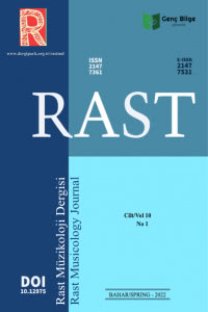Analysis of chromatic mediant relationship in film music score with Neo-Riemannian theory
Film has influenced the public as an important cultural form since the 20th century, and film music, as an integral part of film, plays an important role in shaping its content. Film music was influenced by late European Romantic music, and the Hollywood film score system was established based on composers of European descent, followed by the fusion of numerous emerging musical styles, such as Jazz, Rock, and EDM, etc. The orchestral music as the main composition of the film score has a sense of aural expectation in the sound expression, which largely comes from the chromaticization of the harmonies. When analyzing Hollywood film music, it is inevitable that chromatic harmony progression cannot be accurately expressed by traditional tonal music analysis. This study analyzes the chromatic harmony progression of chromatic mediant relationship in the film scores of four composers from the perspective of neo-Riemannian theory. And the correlation between the four sets of transformations and chromatically harmonic progression, H transformation, PL transformation, LP transformation, and RP transformation, is derived from the comparative analysis of neo-Riemannian theory and chromatic mediant relationship. These transformations have deepened the negative emotions of angst and fear or the positive emotions of grandeur and sacredness in film narratives. Exploring and expanding the use of neo-Riemannian theory in film music analysis has positive implications for the development of film music by demonstrating the rationality, accuracy, and intuitiveness of neo-Riemannian theory in the process of film musicology.
Anahtar Kelimeler:
neo-Riemannian theory, transformational theory, chromatic mediant relationship, Hollywood film score, film music
Analysis of chromatic mediant relationship in film music score with Neo-Riemannian theory
Film has influenced the public as an important cultural form since the 20th century, and film music, as an integral part of film, plays an important role in shaping its content. Film music was influenced by late European Romantic music, and the Hollywood film score system was established based on composers of European descent, followed by the fusion of numerous emerging musical styles, such as Jazz, Rock, and EDM, etc. The orchestral music as the main composition of the film score has a sense of aural expectation in the sound expression, which largely comes from the chromaticization of the harmonies. When analyzing Hollywood film music, it is inevitable that chromatic harmony progression cannot be accurately expressed by traditional tonal music analysis. This study analyzes the chromatic harmony progression of chromatic mediant relationship in the film scores of four composers from the perspective of neo-Riemannian theory. And the correlation between the four sets of transformations and chromatically harmonic progression, H transformation, PL transformation, LP transformation, and RP transformation, is derived from the comparative analysis of neo-Riemannian theory and chromatic mediant relationship. These transformations have deepened the negative emotions of angst and fear or the positive emotions of grandeur and sacredness in film narratives. Exploring and expanding the use of neo-Riemannian theory in film music analysis has positive implications for the development of film music by demonstrating the rationality, accuracy, and intuitiveness of neo-Riemannian theory in the process of film musicology.
Keywords:
neo-Riemannian theory, transformational theory, chromatic mediant relationship, Hollywood film score, film music,
___
- Cohn, R. (1998). Introduction to Neo- Riemannian theory: a survey and a historical perspective. Journal of Music Theory, 42(2), 167-169.
- Cohn, R. (1998). Square dances with cubes. Journal of Music Theory, 42(2), 283-296.
- Cohn, R. (2012). Audacious euphony: chromatic harmony and the triad’s second nature. Oxford: Oxford University Press.
- Cook, N. (1992). A guide to musical analysis. New York: W. W. Norton & Company.
- Cooke, M. (2010). A history of film music. Cambridge: Cambridge University Press.
- Cornelius, S., & Mary N. (2018). Music: a social experience (2nd ed). New York: Routledge.
- Davis, R. (2010). Complete guide to film scoring (2nd ed). Boston: Berklee Press.
- Douthett, J., & Steinbach, P. (1998). Parsimonious graphs: a study in parsimony, contextual transformations, and modes of limited transposition. Journal of Music Theory, 42(2), 241-263.
- Fandom. (2022, June 15). https:// thehungergames.fandom.com/wiki/Horn_ of_Plenty.
- Fandom. (2022, July 17). https://inception. fandom.com/wiki/Dream_Is_Collapsing.
- Fandom. (2022, July 18). https://villainsong. fandom.com/wiki/Gollum%27s_Song.
- Genius. (2022, August 19). https://genius. com/Emiliana-torrini-gollums-song-lyrics.
- Gollin, E., & Rehding, A. (Eds.). (2014). The oxford handbook of Neo-Riemannian music theories. Oxford: Oxford University Press.
- Heine, E. (2021). Chromatic mediants through the context of film music. In Leigh V (Eds.), The Routledge companion to music theory pedagogy (pp. 152-156). New York: Routledge.
- Kalinak, K. (2010). Film music: a very short introduction. Oxford: Oxford University Press.
- Kopp, D. (2006). Chromatic transformations in nineteenth-century music. Cambridge: Cambridge University Press.
- Kostka, S., & Matthew S. (2018). Materials and techniques of post-tonal music (5th ed). New York: Routledge.
- Lehman, F. (2012). Reading tonality through film: transformational hermeneutics and the music of Hollywood. PhD Dissertation. Harvard University, Cambridge, US
- Lehman, F. (2013). Transformational analysis and the representation of genius in film music. Music Theory Spectrum, 35(1), 1-22.
- Lehman, F. (2015). Scoring The President: Myth and Politics in John Williams’s JFK and Nixon. Journal of the Society for American Music, 9(4), 409–444.
- Lehman, F. (2018). Hollywood harmony: musical wonder and the sound of cinema. Oxford: Oxford University Press.
- Lewin, D. (2009). Studies in music with text. Oxford: Oxford University Press.
- Lewin, D. (2010). Generalized musical intervals and transformations. Oxford: Oxford University Press.
- Lewin, D. (2010). Musical form and transformation: four analytic essays. Oxford: Oxford University Press.
- Murphy, S. (2013). Transformational theory and the analysis of film music. In David N (Eds.), The oxford handbook of film music studies (pp.471-496). Oxford: Oxford University Press.
- Ramirez, M. (2013). Chromatic-third relations in the music of Bruckner: a Neo- Riemannian perspective. Music Analysis, 32(2), 155-209.
- Rings, S. (2011). Tonality and transformation. Oxford: Oxford University Press.
- ISSN: 2147-7361
- Yayın Aralığı: Yılda 4 Sayı
- Başlangıç: 2013
- Yayıncı: Genç Bilge Yayıncılık (Young Wise)
